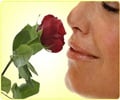New research shows that many people have traces of synaesthesia without knowing it.
New research shows that many people have traces of synaesthesia without knowing it.
Synaesthesia is a condition in which people make unusual associations across the senses.In one common form of synaesthesia, letters, numbers, words and smells are perceived as inherently colored, while in ordinal linguistic personification, numbers, days of the week and months of the year evoke personalities.
Ferrinne Spector and Daphne Maurer at McMaster University in Hamilton, Canada, wanted to explore the coloured and textured smell that some synaesthetes experience.
For the study, researchers asked 78 people who considered themselves non-synaesthetes to smell 22 separate odours in glass jars and assign each a colour and a texture.
The experiment included odours that were both pleasant and unpleasant and familiar and unfamiliar, and that fitted broadly into four categories: food, floral, chemical and environmental. Volunteers were asked to look beyond the obvious, say, orange for an orange scent.
After analysing the results, along with some obvious associations - lemon with yellow and peppermint with smooth, hard and sticky - the researchers found some odd ones.
Advertisement
"The influence of learning is there but it cannot explain all associations," New Scientist quoted Spector, as saying.
Advertisement
However, when the researchers asked volunteers to click on a computer screen to plot where they perceived months to be, non-synaesthetes produced similar arrangements to synaesthetes - including straight lines, curvy lines, ovals, circles and rectangles.
Some were so consistent with synaesthete representations that the researchers decided to divide them not by whether they declared themselves a synaesthete or not, but rather by their accuracy in replicating their own mental representation.
"More consistency predicts a less conventional calendar," Teuscher said.
Teuscher has urged researchers of synaesthesia to be more rigorous. She pointed out that they are all very careful to make sure professed synaesthetes meet the criteria before considering them bona fide synaesthetes, but less so the other way round.
"If people say they don't have synaesthesia, we feel we don't have to validate that and maybe that's a big mistake," she said.
The research was presented in a meeting of the American Synesthesia Association in Hamilton on 27 September.
Source-ANI
RAS/M







